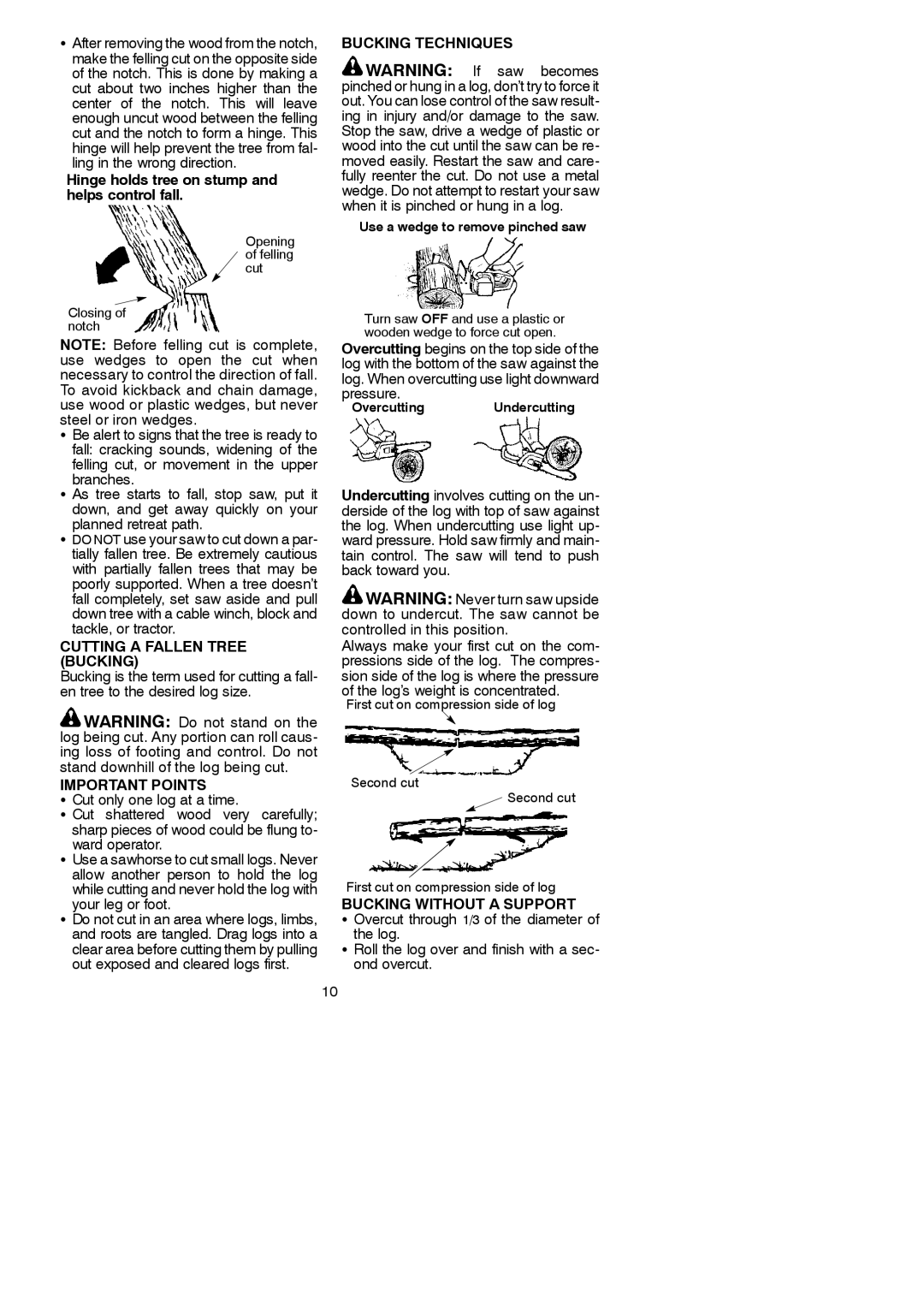
SAfter removing the wood from the notch, make the felling cut on the opposite side of the notch. This is done by making a cut about two inches higher than the center of the notch. This will leave enough uncut wood between the felling cut and the notch to form a hinge. This hinge will help prevent the tree from fal- ling in the wrong direction.
Hinge holds tree on stump and helps control fall.
Opening of felling cut
Closing of notch
NOTE: Before felling cut is complete, use wedges to open the cut when necessary to control the direction of fall. To avoid kickback and chain damage, use wood or plastic wedges, but never steel or iron wedges.
SBe alert to signs that the tree is ready to fall: cracking sounds, widening of the felling cut, or movement in the upper
branches.
S As tree starts to fall, stop saw, put it down, and get away quickly on your planned retreat path.
SDO NOT use your saw to cut down a par- tially fallen tree. Be extremely cautious with partially fallen trees that may be poorly supported. When a tree doesn’t fall completely, set saw aside and pull down tree with a cable winch, block and tackle, or tractor.
CUTTING A FALLEN TREE (BUCKING)
Bucking is the term used for cutting a fall- en tree to the desired log size.
![]() WARNING: Do not stand on the log being cut. Any portion can roll caus- ing loss of footing and control. Do not stand downhill of the log being cut.
WARNING: Do not stand on the log being cut. Any portion can roll caus- ing loss of footing and control. Do not stand downhill of the log being cut.
IMPORTANT POINTS
SCut only one log at a time.
S Cut shattered wood very carefully; sharp pieces of wood could be flung to- ward operator.
SUse a sawhorse to cut small logs. Never allow another person to hold the log while cutting and never hold the log with your leg or foot.
SDo not cut in an area where logs, limbs, and roots are tangled. Drag logs into a clear area before cutting them by pulling out exposed and cleared logs first.
BUCKING TECHNIQUES
![]() WARNING: If saw becomes pinched or hung in a log, don’t try to force it out. You can lose control of the saw result- ing in injury and/or damage to the saw. Stop the saw, drive a wedge of plastic or wood into the cut until the saw can be re- moved easily. Restart the saw and care- fully reenter the cut. Do not use a metal wedge. Do not attempt to restart your saw when it is pinched or hung in a log.
WARNING: If saw becomes pinched or hung in a log, don’t try to force it out. You can lose control of the saw result- ing in injury and/or damage to the saw. Stop the saw, drive a wedge of plastic or wood into the cut until the saw can be re- moved easily. Restart the saw and care- fully reenter the cut. Do not use a metal wedge. Do not attempt to restart your saw when it is pinched or hung in a log.
Use a wedge to remove pinched saw
Turn saw OFF and use a plastic or wooden wedge to force cut open.
Overcutting begins on the top side of the log with the bottom of the saw against the
log. When overcutting use light downward pressure.
Overcutting Undercutting
Undercutting involves cutting on the un- derside of the log with top of saw against the log. When undercutting use light up- ward pressure. Hold saw firmly and main- tain control. The saw will tend to push back toward you.
![]() WARNING: Never turn saw upside down to undercut. The saw cannot be controlled in this position.
WARNING: Never turn saw upside down to undercut. The saw cannot be controlled in this position.
Always make your first cut on the com- pressions side of the log. The compres-
sion side of the log is where the pressure of the log’s weight is concentrated.
First cut on compression side of log
Second cut
Second cut
First cut on compression side of log
BUCKING WITHOUT A SUPPORT
S Overcut through 1/3 of the diameter of the log.
SRoll the log over and finish with a sec- ond overcut.
10
